Tired of fruit flies invading your home? Discover six proven methods to naturally and effectively eliminate these pesky insects using simple traps and preventative measures!
Identifying and Understanding Fruit Flies
If trying to identify whether the problem is a fruit fly, a drain fly, or some other type of insect, remember that the fruit fly is about an eighth of an inch in length and has a brownish hue.
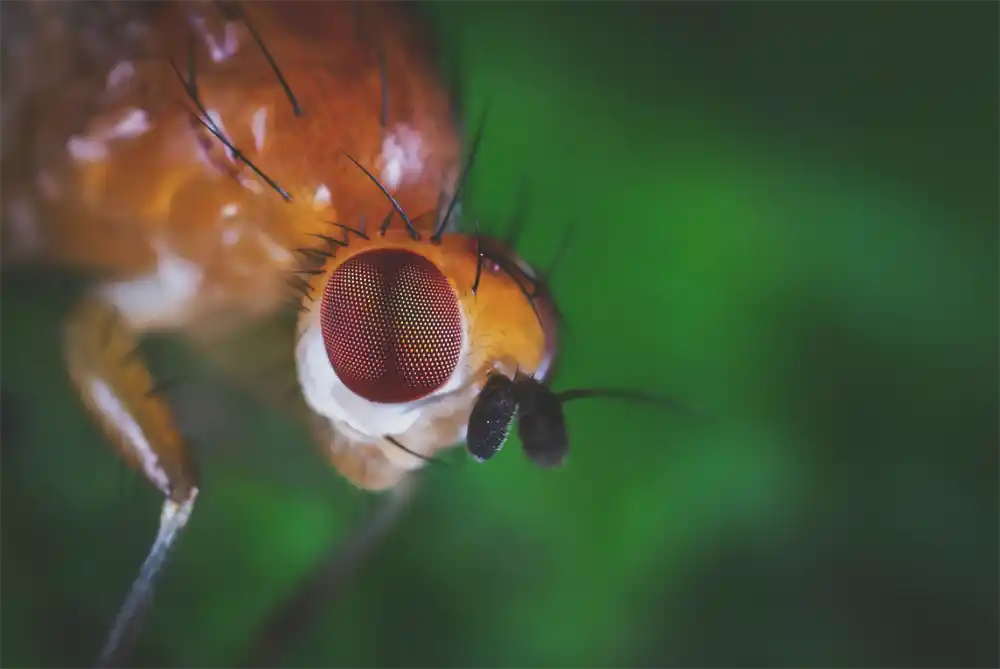
One of the more interesting things about the fruit fly is that it has red eyes. If one is swatted and the little creature has red eyes, and there is a magnifying glass available, that is one thing that will be noticed. It usually takes about one week to go from egg to full adult, so a problem can happen super quick.
How Fruit Flies Invade Homes
Fruit flies can come in off of produce. If you’ve ever noticed bringing bananas in, or maybe apples or something like that, and then maybe a week later there is a tremendous fruit fly problem, a lot of times the fruit flies can lay their eggs on the banana or other produce brought in.

That’s where they start from; they actually come in from the grocery store a lot of times. They’re sprayed, but that doesn’t always kill them, and sometimes grocery stores themselves have a fruit fly problem.
Entry Points for Fruit Flies
Produce itself is where they’re coming from. A fruit fly can be attracted to the smell of overripe fruit. Let’s say there are some bananas in the kitchen and there is a tiny little gap on the windowsill that may not even be noticeable. Fruit flies can smell that from outside; it’s hard to believe, but they can, and they’ll come in under that windowsill.

They can also enter through an open window if a window is left open in a nice time of year and there’s not a screen there, or if there’s a small cut in the screen. A fruit fly can come through the smallest, tiniest little opening, and that often can happen around a kitchen door if there isn’t a perfect seal.
Usually, they find their way inside through tiny little openings.
Preventative Measures
Refrigerate and Wash Produce
A way to cut down on a fruit fly population is when produce is brought in, put it in the refrigerator to hinder the development of those eggs on the surface.
It is extremely important to use a vegetable wash. Very safe vegetable washes can be used that will not contaminate produce if the apple skin is eaten or something like that, where there is no desire for produce to be contaminated by some strong chemical.
Use an organic wash. Two important things to do are to limit their food source with refrigeration and washing produce with the appropriate product.
Clean Drains
Drains in kitchens and bathrooms can be a breeding area for the fruit flies, especially kitchen drains where it’s in close proximity to the fruit that’s become too ripe and that’s where the eggs have hatched out. The best way to approach the kitchen is to make sure that the drain is clean.
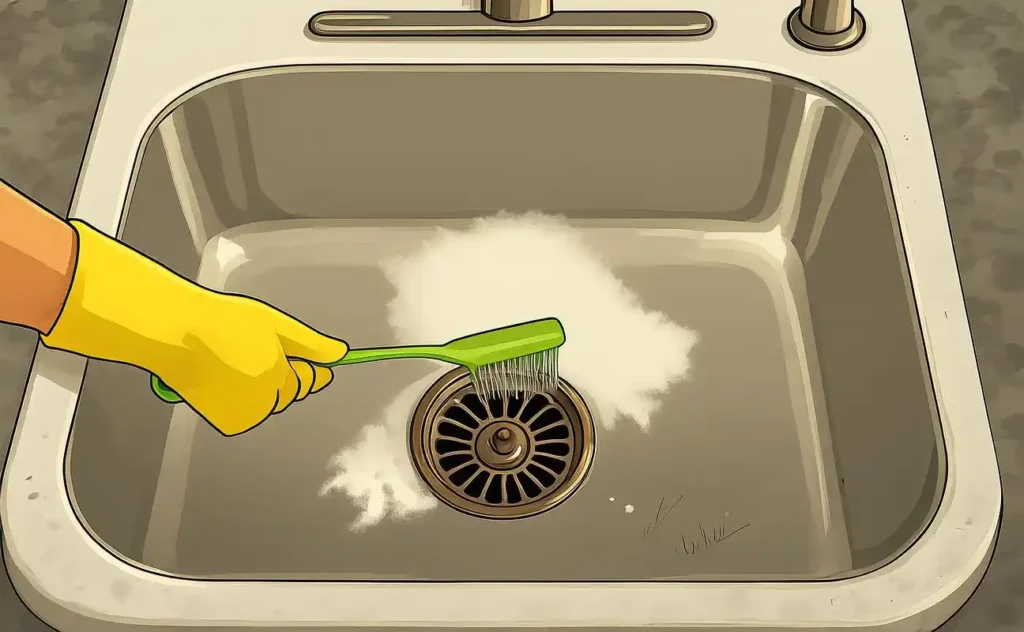
Two routes can be taken with that type of cleaner: a strong chemical route, or trying to find a natural cleaner.
Be careful using strong chemicals because if there is a septic system and those strong chemicals make their way to the septic system, it can kill off some of the beneficial bacteria in the septic system. If a lot of Clorox is poured down the drain and there is a septic system, it could destroy the entire balance of the septic system and there might be a big problem at some point in the future.
In bathroom drains, shower drains sometimes can go months and months without use if it’s in a third bedroom or guest bedroom, and those drains can be unused and it’s the perfect place for those flies to start multiplying. Be careful about using these products in drains.

Clean Sink Overflows
On sink drains in bathrooms, on the back side of the sink there’s an overflow. If filling up a drain with a stopper prevents the sink from flooding onto the floor, those little overflows are the perfect place to breed for fruit flies. They love to get in there because there’s moisture and a lot of humidity coming up from the daily use.
Pour something in the overflow with a funnel and rinse it out. Clean that area out.
Secure Trash and Compost
The most common place that a lot of fruit flies are going to breed is in the kitchen trash because someone will throw away a banana peel, and that is the perfect place for the fruit flies to get started. When throwing away apple cores and banana peels, put them inside of a bag and seal it tightly.
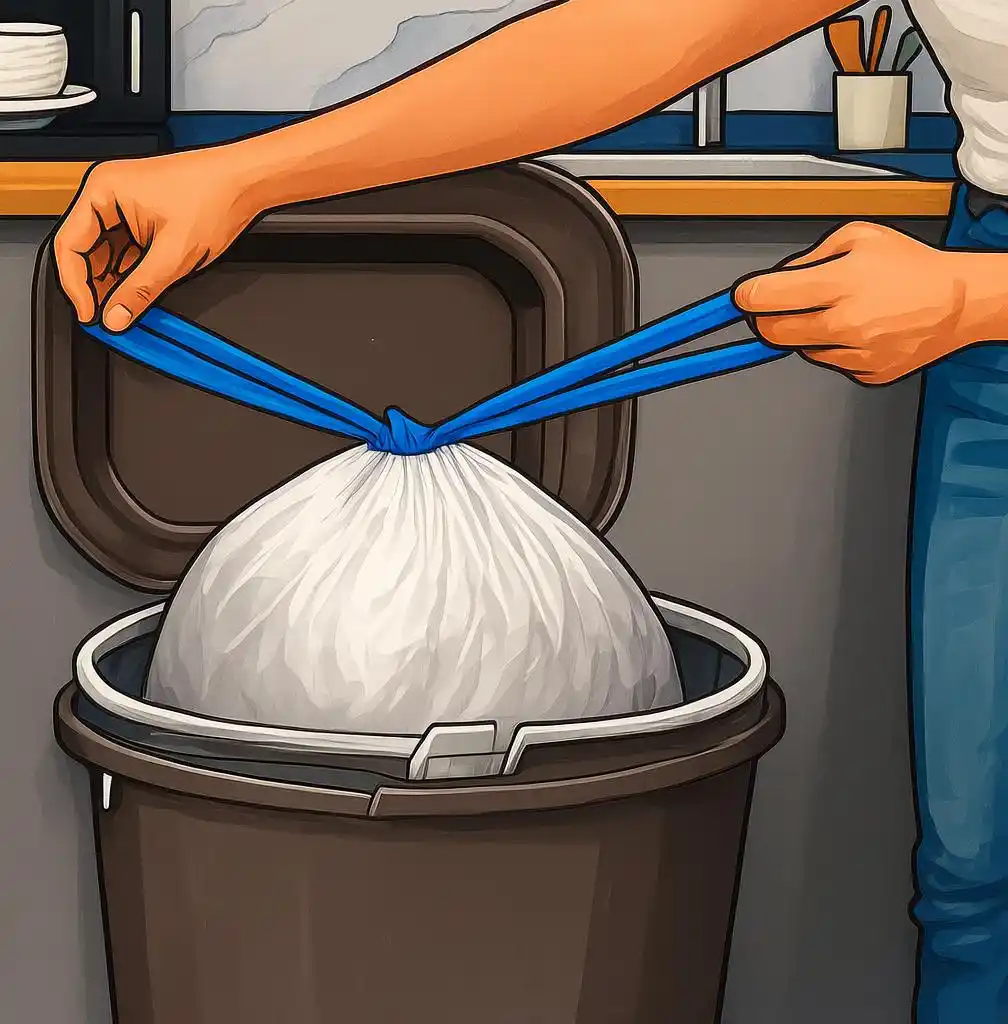
If it’s just laying on top of the trash, the fruit flies can make their way in there, and they multiply rapidly if there were some eggs on the core or on the skin of the apple or on the banana peel. If composting a lot of leftover vegetables and stuff, make sure to put it in a sealed container, preferably outside of the living area, possibly in a basement garage, maybe the back porch.
Even though these have tops on them, they’re not perfectly sealed, and it’s very easy for the fruit flies to get in and out. Just make sure this is not stored in the living area of the house because there’s going to be an explosion of fruit flies from all of the stuff that’s decomposing.
Repair Window Screens
If fresh air is desired by opening windows in the spring and the fall, make sure that window screens don’t have any small cuts. A fruit fly is so small it can get in through some of the smallest little imperfections in a screen. If there is a tear on one of the screens, that just is an open door for the fruit fly because they will stay on that screen all day until they find a way into it.
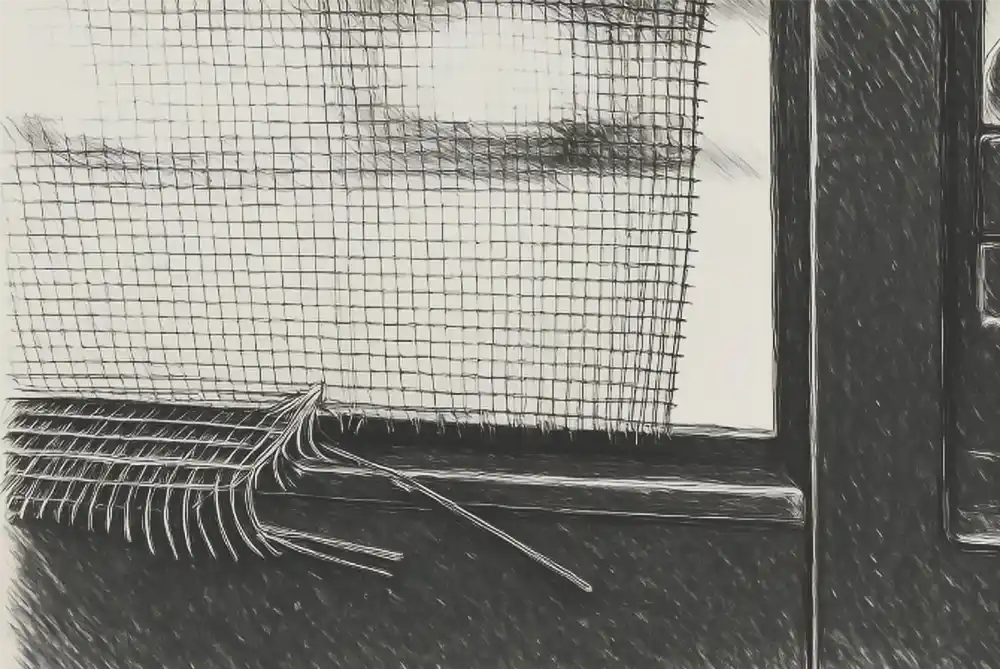
If the window is open, it’s that little quarter of an inch cut that’s how they’re going to get in. Take a close look at the window screens and replace them if needed. Use a high-quality screen. Some of the higher-end screens have more strength, so if there’s something hits it, those really high-quality ones don’t rip as easily as the lower-quality ones do.
Monitor Potted Plants
A lot of potted plants in the house can be another area where fruit flies find paradise. This is especially true if the plants are overwatered. If it’s suspected that the fruit flies are starting from potted plants, take some neem oil and put it in a spray bottle.
If the soil is too wet, Neem oil is all-natural, it’s safe, and won’t hurt pets, but it will get rid of those fruit flies if they’re hatching out and buzzing around a house plant.
Use Basil and Essential Oils
To deter fruit flies, basil can be used. There’s a strong odor that comes from basil, and it can be placed on the countertops in cups with a little bit of water. The purpose of this basil is to repel them; fruit flies don’t like the strong odor of basil, and so that’s one of the things that can be strategically put around the kitchen to drive them out.
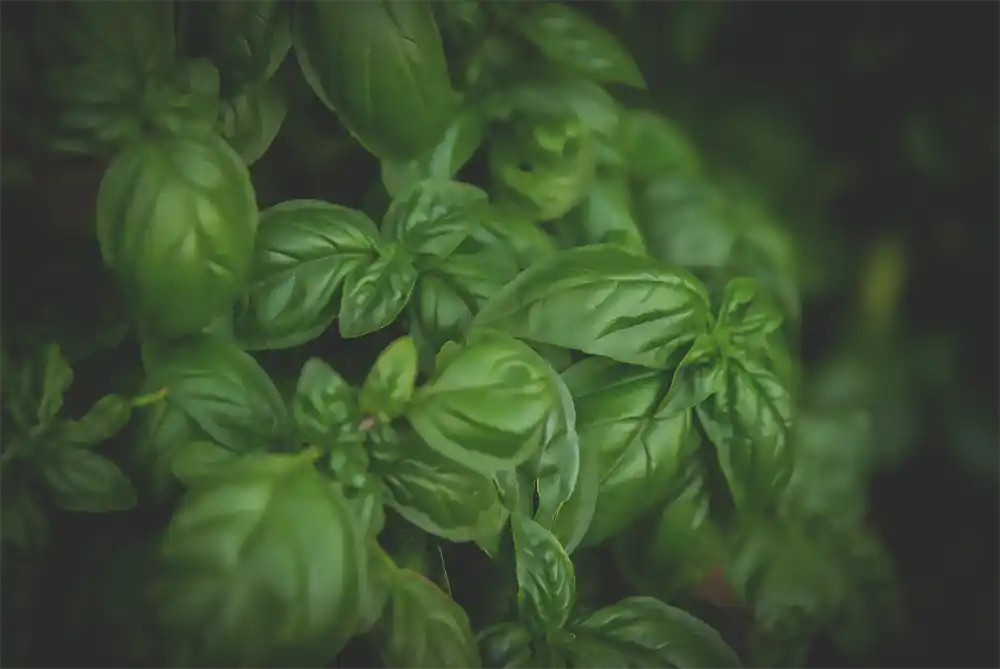
Another great thing that can be used if there is no basil on hand is essential oils, specifically lemongrass. They do not like the smell of citrus, and that smell lemongrass oil will help. Putting some of that in a small bowl and letting that air circulate around the room can also drive them out.
Consider a Dehumidifier
If the house is excessively humid, consider getting a dehumidifier because fruit flies don’t like arid-type environments; they want that very moist, humid environment. If there is too much humidity in the air, a small dehumidifier in the kitchen can help.
Effective Fruit Fly Traps
The Vinegar Trap
The first trap involves a vinegar of some type, such as fermented vinegar, red wine vinegar, balsamic vinegar, or apple cider vinegar.
Here’s how to make the trap, and this is one of the most effective ways because they’re attracted to that vinegar.
The Wine or Beer Trap
The second type of trap that’s very effective is a wine or beer trap. Wine or beer attracts fruit flies and it is super simple to make this type of trap.
The Overripe Fruit Trap
The third type of trap that’s most commonly used and effective involves overripe fruit, usually either banana, apple, or cantaloupe, something that’s going to ferment very quickly if it stays out on the kitchen counter.
Homemade Trap Instructions
The first trap uses dessert cups that come with their own lid. These can be reused over and over. Punch three or four small holes in the top so the fruit flies can get in there.
Put just a little bit of apple cider vinegar in the trap. Then, put just a little bit of soap. Any kind of dish soap will do. Put one or two drops to break the surface tension. That will sit on the surface of the top of the apple cider vinegar, and when the fruit fly goes into the trap, they fall through that surface tension.

Add a little bit of yeast, just a tiny bit. That’s going to also help, and the smell of that carbon dioxide will attract the fruit flies right to the trap and it will be more effective. Swirl it around there to get it stirred up.
The second trap is the beer or wine trap. Either use a beer can or a wine bottle, leaving just a small amount, maybe just a quarter of an inch at the bottom. Put dish soap in the can or bottle, and it’ll do the same thing. They’ll be attracted to the fermented alcohol, and they’ll go right into the wine bottle or beer can.
The third type of trap involves putting a piece of rotten fruit, apple, whatever is available, banana, in the trap. Then put a little bit of dish soap around it, and as that piece of fruit or vegetable continues to rot, it will attract fruit flies.
Alternative Traps
If there are no dessert cups available and no pen, an old jelly jar can be used. Clean it out, or if you don’t decide to clean it out, the jelly in there might continue to ferment, and a small kitchen funnel can be used. Tape around the edges of it to make sure they can’t get out easier and do the same two methods there.
If there is no funnel, a funnel can be made out of a piece of paper and some tape.
Lemon Trap
This trap only requires a lemon. Take an empty jar, put the lemon in it. If there is no funnel, the cap can be used, and holes can be punched in the cap. Use a small kitchen funnel, tape around it to make sure they can’t get out through the sides. They go down into the funnel, and it’s hard for them to get out. As that lemon starts to ferment and get older, it too will attract them and they will be trapped.
Old Milk, Sugar, and Pepper Trap
An old recipe, over a couple of hundred years old, involves taking one pint of milk, 4 ounces of sugar, and a teaspoon of pepper, putting it in a saucepan, cooking it, and leaving it on the stove for a day or two. That is supposed to attract the fruit flies to it.
Yeast and Sugar Trap
If there is yeast and sugar, put some warm water in a jar, a small amount of sugar, maybe half a teaspoon, and one teaspoon of yeast or half a teaspoon somewhere in there, and maybe two teaspoons of sugar.
As that sugar starts to ferment, that carbon dioxide will also draw them to it. Use the funnel or the paper funnel trick, or actually punch holes in the lid. Make sure that it’s sealed so they can’t get out easily and that sugar and yeast when it’s fermenting will draw them right to the trap.
Highlights
Rapid Reproduction
7-day lifecycle requires early action.
Produce Vector
Wash/store bought fruit to prevent eggs.
Soap Breaks Tension
Makes traps drown flies effectively.
Drain Breeding
Clean overflows & drains.
Seal Trash
Use airtight bins.
Dry Plants
Avoid overwatering.
Reduce Humidity
Dehumidify damp areas.
DIY > Commercial
Cheaper, equally effective.
Conclusion
Eliminating fruit flies can be achieved through a variety of methods, from preventative measures like keeping your kitchen clean and produce fresh, to creating simple, effective homemade traps. By employing these strategies, you can effectively manage and prevent fruit fly infestations, ensuring a more pleasant and pest-free environment.